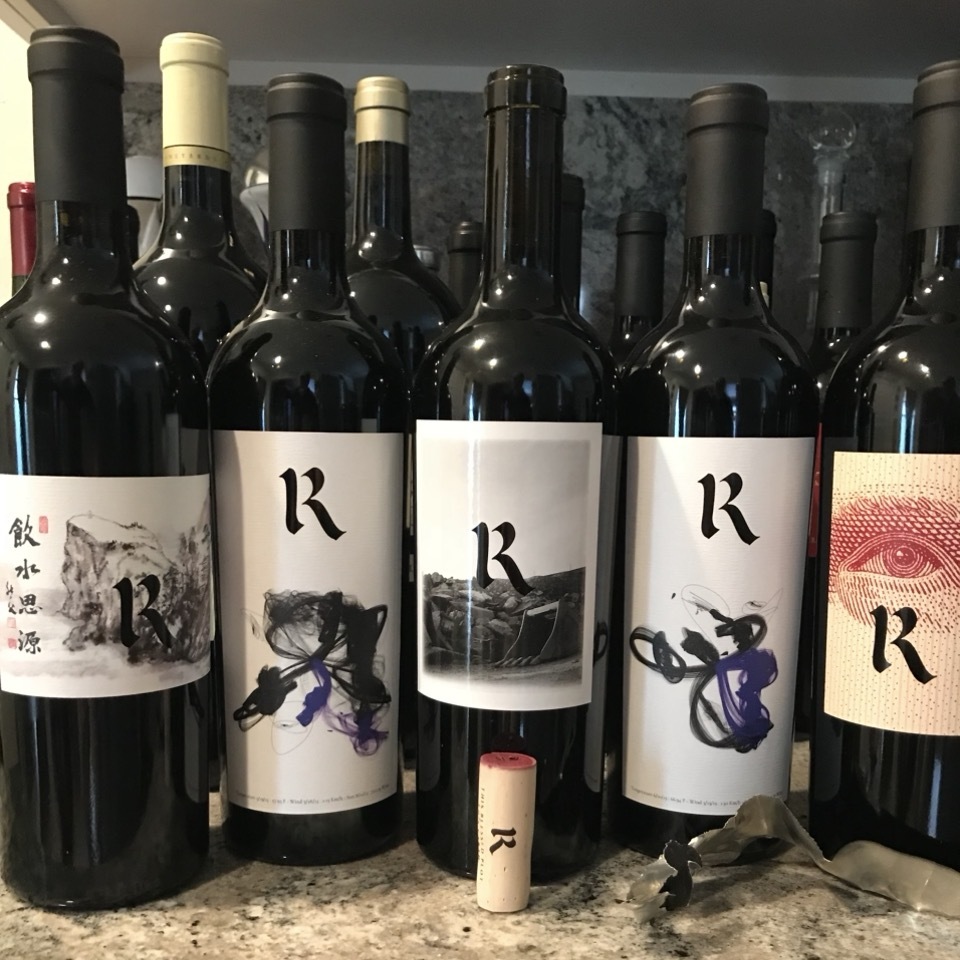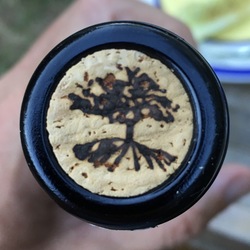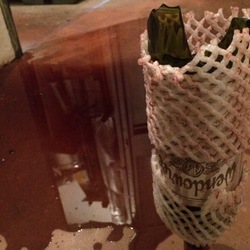Natural Process Alliance
Valdespino
Quina Jerez De La Frontera Pedro Ximénez
Perfecto!
An old, Chinchona infused vermouth that’s date, anise, bitter luscious.
Based on 20 yr. Oloroso.
W some soda on a hot day, pow!
@Delectable Wine : This is Valdespino Quina.
HISTORY
The history of the aperitif dates back to the 5th century B.C. when Hippocrates concocted a wine-based beverage macerated with wormwood flower and other herbs, which was traditionally used as a restorative and an appetite stimulant. In the late 1700s, in Italy, a flavored wine called "vermouth" was introduced as an appetite booster before meals. This tradition later spread to France and Spain.
In Spain, the aperitif and the "tapa" have together contributed to create a unique "social occasion" which has gradually become a key attraction for the general public and tourists worldwide; that is, the longstanding association of social gatherings with Spanish gastronomy.
The main difference between Spanish aperitifs (Vermouth and "Quina" or Tonic Wine, in particular) and their French and Italian counterparts lies in the quality of the aromatic flavors and the botanicals and fruits employed. Spanish aperitifs are somewhat sweeter and lighter, whereas Italian aperitifs are distinctive for their bitter flavor, while their French counterparts tend to be drier.
VALDESPINO AND
THE ORIGIN OF THE APERITIF
The connection between the Valdespino family and the aperitif dates back to the end of the 19th century and became especially relevant in the first quarter of the 20th century, at the height of the sherry wine boom.
By 1920 the House of Valdespino was already producing several wines macerated with root extracts and botanicals. They were called "tonics" and "quinados" and were recommended as "tonic – aperitifs" or "fortifiers", as shown on the labels of the time.
From 1930 until the second half of the 20th century, The House of Valdespino was particularly active in the production of beverages macerated with different botanicals, fruits and bitter root extracts (cinchona bark and vermouth). The company marketed several wines with considerable success, mainly on the domestic market but also in countries like the USA, where, in the 60s, Valdespino, together with their associate Jack Poust, launched a vermouth with orange called "Tomboe", designed mainly for the younger clientele.
Thanks to the boost provided at the time by the export of sherry wines to England and its overseas provinces, there was a boom in the production of wines made, or rather, macerated with the root of Cinchona Calisaya, whose bark, popularly called "quina", was the basis of quinine, an extract that contributed effectively to malaria prevention.
Since then, Valdespino has been macerating and bottling blends of different varieties of their own sherries.
THE ORIGIN OF
THE "JEREZ APERITIF"
The Estévez family, owners of Bodegas Valdespino since 1999, carried on with this tradition, and continued to macerate old wines from the different Valdespino soleras with various botanicals, natural extracts and fruits. These were small productions and batches, bottled for their own consumption, elaborated experimentally and in advance of what has now become the family's new collection.
The launching in 2021 of "Valdespino Aperitifs" represents an important milestone for the company, since it is a unique range in the Valdespino catalogue.
Valdespino's original "Tonic for the Sick" label, dating back over a century, has been selected in an attempt to recover some of the iconic designs from the family labels museum. The image, somewhere between Art Deco and vintage, has inspired the design, which is intended as a benchmark for today's aperitif ranges.
This is the first time that a Jerez winery has developed a collection of aperitifs by recovering old recipes and original labels from the early 20th century, using Very Old Oloroso Wines from the founding soleras of the Jerez firm, which today constitute our prized "VOS" and "VORS" (Sherry Wines of an average of over twenty and thirty years of age, respectively).
VERMOUTH
A coupage of Very Old Oloroso Sherry Wine (aged for 15 years) and Moscatel, which provides a stylish citrus note. After undergoing a hydro-alcoholic maceration process with bitter extracts of mugwort, coriander, elderberry and gentian, together with chamomile flowers, aromatic cloves, cinnamon, dried Seville oranges and juniper berries, the final blend is then aged in barrels which have previously contained Valdespino Oloroso Wines, all these coming together to make an intense and complex vermouth with a sumptuous balance of aromas.
This vermouth is a signature aperitif with an unmistakable identity characterized by the prominence of the Old Oloroso from Jerez, alongside an elegant dash of bitterness, which is offset by the sweetness of the Moscatel. The result is a subtly balanced taste with unique spicy and citrus notes provided by the botanicals and fruits.
Bright mahogany color with coppery tones.
Intense spicy aromas with hints of Oloroso Sherry.
Citrus notes from oranges, with a lovely, spiced blend of clove and gentian. An elegant, enveloping bitterness resulting in a complex yet smooth palate. Warm and welcoming, faintly sweet aftertaste.
Serve in a tumbler glass, with ice and a slice of grapefruit or orange. Ideal as an aperitif, accompanied by nuts, olives and pickles, it also combines superbly with canned fish tapas such as anchovies, pickled tuna and the like.
QUINA
This aperitif is the result of the coupage of 20-year-old Oloroso Wines with Pedro Ximenez from the soleras of our iconic PX "EL Candado". The procedure involves a hydro-alcoholic maceration process of Cinchona bark (Quina) with gentian root, natural licorice extract and nutmeg, along with a selection of dried citrus fruits, such as grapefruit and Seville oranges.
The result is a stylish, complex, one-of-a-kind aperitif with a bitter refreshing note. The Pedro Ximenez also provides a characteristic nuance of dried fruit (sultanas, dried figs, dates) that makes this tonic wine ever more unique.
A fresh and sweet palate with citrus and slightly tart notes, all wrapped up in a spicy combination of cloves, nutmeg, cinnamon, vanilla … leaning into the sweet reminders of the Oloroso Sherry barrels where it is aged.
Dark mahogany color with coppery tones.
Spicy aromas with vegetal notes from the botanicals and Oloroso Sherry.
Slightly bitter notes of Cinchona, combining well with the botanicals (licorice, nutmeg) and hints of dried fruits (dates, sultanas). A stylish citrus touch and the quinine bitterness bring about a warm, lingering aftertaste.
Ideal as a complement in cocktails (Rum Old Fashioned, Negroni, Mahattan, etc), it also makes for a perfect aperitif in a tumbler glass, on the rocks, with a cinnamon stick and a twist of orange.Serve with crisps, olives and pickles.
BODEGAS VALDESPINO
CTRA. N-IV, KM. 640 - 11408 - JEREZ, SPAIN
Bodegas Valdespino - All rights reserved 2021 — 3 years ago

I looked up that Syrah you posted, In U.S. I found 1 seller, in CO. Pick up only $53 Ha!

Château Guiraud
Sauternes 1er Grand Cru Classé Sémillon-Sauvignon Blanc Blend 2020
Chateau Guiraud is mainly known for amazing Sauternes terroir-driven (botrytis-styled) wines, natural vineyards and very jealous preserving the genetic sources of its grape varieties.
This 2020 vintage was released to honor its 10th anniversary of being AB (“Agriculture Biologique”) certified, and also was a very good year for a great white wine.
An outstanding blend of Sauvignon blanc 70%, Sémillon 30%, with an unique vilification process; fermentation was for 3 weeks in barrels having previously been used for the vinification of its flagship Sauternes and underwent through MLF at 35%, and aging in barrels for 12 months.
The nose welcomes all baked tropical fruits and very distant hint of white flowers. As for tasting, a very rich and texturized white with gentle acidity and creamy lemon zest with an impressive silky mouthfeel, it also has a subtle astringency with undertones of delicacy towards the back-end of the palate.
This wine seats next to my most preferred complex, age-worthy whites as Gran Vin de Bordeaux. Salute! — 7 months ago
Château Maris
Le Zulu Syrah Grenache 2019
No added sulfites it says. So it also says it’s, ‘Organic Wine’ and ‘Vegan’. Label art looks kinda French. Fun French…
Color is dark and pretty. Deep magenta. Smells like ripe forest berries and summer/early fall winds from the hills. (I mean rocks and dust with a some bushes and oak trees). Flavors are unique. Creamy? A hint of unsweetened, whipped heavy cream. With blueberries in it. Cooked blueberries. Also a bit of hibiscus tea on the finish. This is excellent for ‘natural’ un-sulfured red. Even has a zingy vibrancy 4 years on. This is pretty classic southern France G and S (Grenache and Syrah). Nice work Vinters Alliance for finding it and bringing it to the USA. Glad it ended up at Grocery Outlet for $6-7! — 2 years ago
Domaine Truchetet
Fleur de Pinot Bougogne Pinot Noir 2020
Per Bianca of PBB: Made from 100% Pinot Noir vines, farmed organically and planted on clay and silt soils at two vineyard sites – Les Chaillots and Les Argillières. The grapes are harvested by hand, with careful sorting in the vineyard and in the cellar to make sure only the highest quality of grapes are used for the resulting wine. The grapes are then 100% destemmed after a short cold maceration, fermented with indigenous yeasts, and finally gently pressed at the end. All the work is done by gravity and without major machinery, ensuring that everything is handled delicately and with great care. This is one of their zero-zero cuvees, with no sulfur added at any point during the winemaking process, something that we see with natural wines all over the world, but still, a special task to take on within the old-school wine culture of Burgundy. This wine is supple, fruit-forward, and deep purple in color. There is a light but clean style of reduction, and a balance of juiciness and acidity that makes this wine incredibly drinkable with understated elegance. — 3 years ago
Andra Årgången
Pinta White Blend 2021
A new project in Gotland started by Andrea Guerra and his wife Emma Serner. The Långmyre vineyard is about 5 hectares of vines planted to 3 white and 2 red varieties; all hybrids in order to deal with the unique conditions of the island. The vineyard is certified organic. In the cellar, they wouldn’t categorize themselves as natural winemakers but it’s quite clear they have a light hand when it comes to the process. The vineyard was planted in 2018 so yields are minuscule and they currently have nothing to sell. They are producing a Rosé, a still White and a Red with plans to produce a sparkling white in the traditional method beginning with the 2022 vintage. If these early vintages of Pinta are any indication of what’s to come, the potential for their whites are quite simply undeniable. This particular bottle of 2021 “Pinta” was opened two days prior and presented by Emma. In the glass, the wine appears a bright, light straw color with no signs of gas or particles. On the nose, “Pinta” is tremendously floral with notes of white flowers, gooseberries, melon, grapefruit, and a slight herbal character that seemed to generally relate to the Gotlandian flora. On the palate, the notes were confirmed along with a rather remarkable savory minerality and a slightly waxy texture; both things that I found to be especially charming. Acid was medium and the finish was long and satisfying. This is a project to keep an eye on and I sincerely look forward to following their progress. A true revelation.
— 3 years ago
Oscar Adrian Mancillas De La Torre
Textura Rosa 2023
2023 Textura Rosa, Valley de Guadalupe Mexico
One of the very few natural wines where I find the process (or lack of process?!) complimentary to the grape instead of diminutive or downright rude!
A mix of red fruit on the nose - both over ripe strawberry and ripe tart bing cherry.
The taste carries the tart bing cherry notes with a wonderfully fresh acidic finish. I would never guess that this was grown so far south of the 40th parallel
Voraz, CDMX — a year ago
Gut Oggau
Timotheus Trocken Grüner Veltliner Weissburgunder
the perfect ides of what a fresh, tropical ans satiny natural wine should taste like. its easy drinking, playful and fun, yet you can also sense a deep complexity that went into the vinification process. Plus, the story and wine naming methods of Gut Oggau connects the drinker to the wine in such an interesting way.. love! — 2 years ago
Dalwhinnie
Moonambel Shiraz 2012
Not bad for $30.00 Web notes This iconic estate nestled into a natural amphitheatre 2,000 feet up in Victoria's Pyrenees mountain range produces some of the country's most highly regarded and awarded wines The vineyard was established in 1976 and is the highest and most remote in the Pyrenees region. All the vines are dry farmed and naturally low yielding due to the very poor rocky soils. The elevation of the site means that they experience dramatic diurnal swings in temperature, the cool nights drawing out the growing season and preserving excellent natural acidity in the wines. The slow gradual ripening process results in more complex flavor development and bestows the wines with exceptional longevity. These wines whilst being remarkably good young will be excellent prospects for a decade plus in the cellar. Winemaker's Notes: "Our 33rd vintage of this wine is an intense purple-black colour. The complex bouquet displays raspberry and dark cherry fruit, a savoury black olive note and an exotic graphite element. The weight is medium but the attack is immensely powerful and persistent. Wonderful juicy sweet-sour dark fruit is framed by fine ripe tannins. This is a wine to decant and enjoy now or keep for the long term. — 3 years ago

Raina
Campo di Colonnello Umbria Bianco Trebbiano Spoletino 2021
Perhaps the more focused wine from Raina which is a family natural winery that doesn't forget the tradition. Only little sulphites used in the whole process(just before bottling), nothing else added.
6 days maceration, indigenous yeast and 6 months on the lees in stainless steel.
Result is orangy with vivid mineral that leads the sip. It doesn't tire your palate, it's a little less than intriguing because goes down too quickly.
It's long too
Excellent price point is a plus
I reckon this is a very good effort
A little bottle age would help too i guess — 3 years ago










Freddy R. Troya
Koghba – Koghbeni Grape / Reserve Red / 2021
Tavush Region – Armenia 🇦🇲
Overview
Crafted from the rare indigenous Koghbeni grape, this Reserve is produced through a meticulous process: clusters are left hanging on the vine until reaching ~26% sugar concentration, then undergo a slow, complex fermentation. The wine is aged for at least one year in lightly toasted barrels, followed by another year in bottle before release. Quantities are extremely limited, making this a collector’s gem.
Aromas & Flavors
Rich notes of dried plum, raisin, and black fig interlace with cocoa, leather, and a whisper of spice. The extended hang time brings concentrated, almost Amarone-like depth, while still holding its Armenian mountain freshness.
Mouthfeel
Velvety and full-bodied with an elegant balance of natural sweetness and tannic grip. Long, persistent finish with raisiny echoes and warm spice tones.
Food Pairings
Perfect alongside braised short ribs, lamb shanks, beef stew, or aged cheeses like Manchego or Motal.
Verdict
A powerful, distinctive expression of Armenia’s winemaking tradition. Think of it as Armenia’s answer to Amarone or Ripasso, yet rooted in its own terroir and grape heritage.
Did You Know?
The Koghbeni grape is indigenous to Armenia and almost unknown outside its local terroir. The technique of drying grapes on the vine before vinification mirrors the ancient methods that gave rise to Italy’s Amarone, showing how old-world traditions can emerge independently across cultures.
🍷 Personal Pick Highlight
This wine is remarkable not only for its scarcity but also for how it bridges familiar Amarone-like notes with an Armenian identity. A genuine standout worth savoring slowly. — 10 days ago